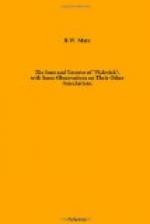Having disentangled himself from the dilemma, he found the intricacies of the “White Horse’s” landings .and stairs again too much for him, until he was discovered, crouching in a recess in the wall, by his faithful servant Sam, who conducted him to his right room. Here Mr. Pickwick made a wise resolve that if he were to stop in the “Great White Horse” for six months, he. would never trust himself about in it alone again.
We do not suppose that the visitor would encounter the same difficulty to-day in getting about the house as did Mr. Pickwick; but torturous passages are there all the same; and by virtue of Mr. Pickwick’s experiences they are perhaps more noticeable than would otherwise appear had not his adventures been given to the world. And so the fact remains that Mr. Pickwick’s spirit seems to haunt the building, and no attempt is made to disabuse the mind that his escapade was anything but an amusing if unfortunate reality.
The double-bedded room is a double-bedded room still, with its old four-posters, and is shown with great pride to visitors from all over the world as “Mr. Pickwick’s room.” The beds are still hung with old-fashioned curtains, and a rush-bottomed chair has its place there, as it did during Mr. Pickwick’s visit. Even the wall-paper is not of a modern pattern, and may have survived from that historic night. At least these things were the same when we last visited it.
Indeed, all the rooms have still the atmosphere of. the Victorian era about them. The coffee-room, the bar-parlour, the dining-room, the courtyard and the assembly room reflect the Pickwickian period, which in other words speak of “home-life ease and comfort,” and “are not subordinate to newfangled ideas.” Whether the small room in the vicinity of the stable-yard, where Mr. Weller, senior, was engaged in preparing for his journey to London, taking sustenance, and incidentally discussing “Widders” with his son Sam, exists to-day we are unable to state with any certainty; but no doubt there is one which would fill the bill. Which, too, was the particular room where Mr. Pickwick and Mr. Tupman were arrested, the former on the charge of intending to fight a duel, and the latter as aider and abettor, history does not relate, or modern research reveal.
The inn is some four hundred years old, and at one time was known as the White Horse Tavern. George II is said to have stayed there some three hundred years ago, and so, report has it, did Nelson and Lady Hamilton; but these are small matters compared to the larger ones connected with Mr. Pickwick, and merit but passing record. Whilst those details concerning the fictitious character can be adjusted by any enthusiast who stays at the “Great White Horse” on a Pickwickian pilgrimage, no tangible trace that the three other historical personages used the inn remains to substantiate the fact, although the tradition is acceptable.




